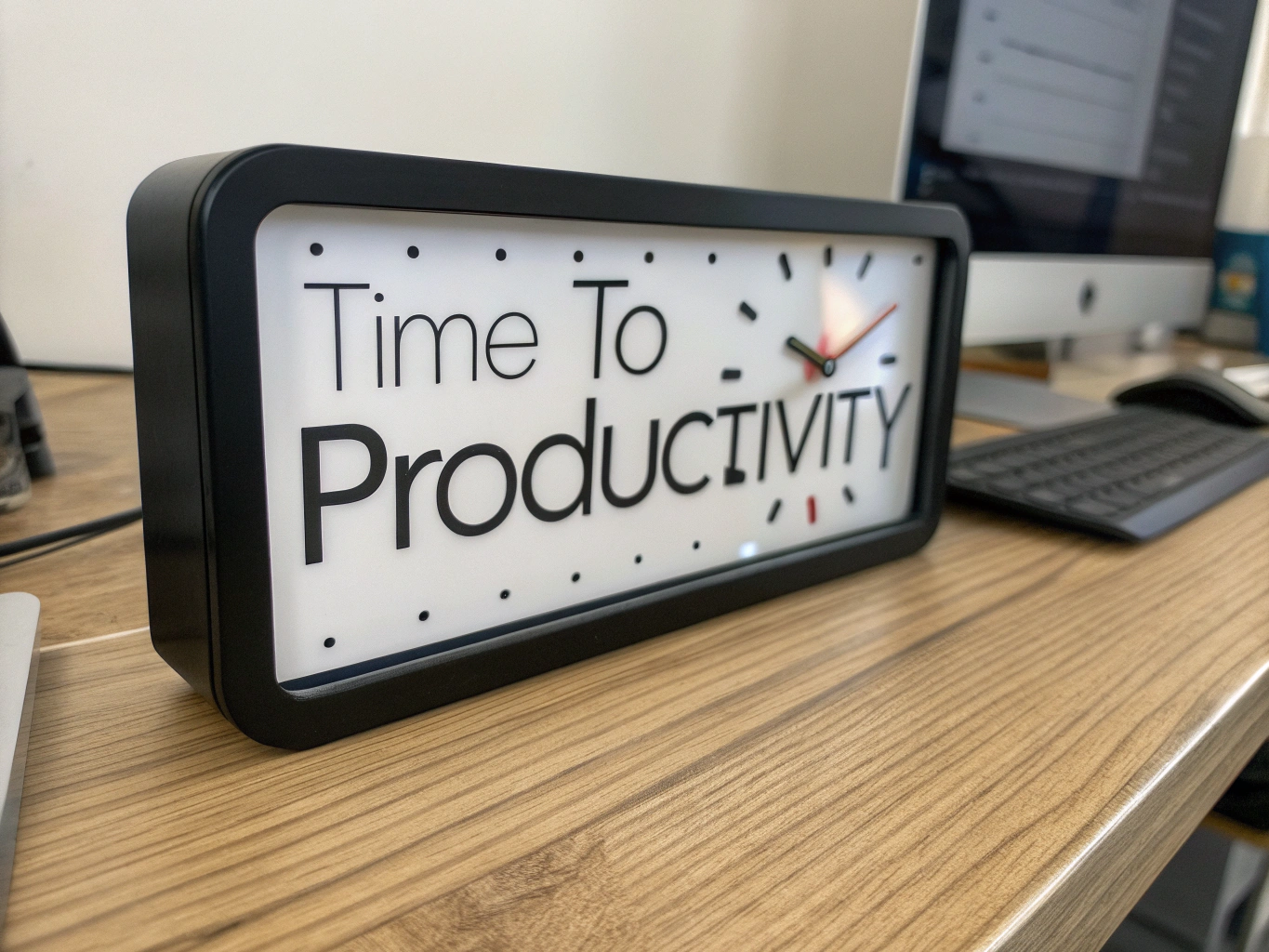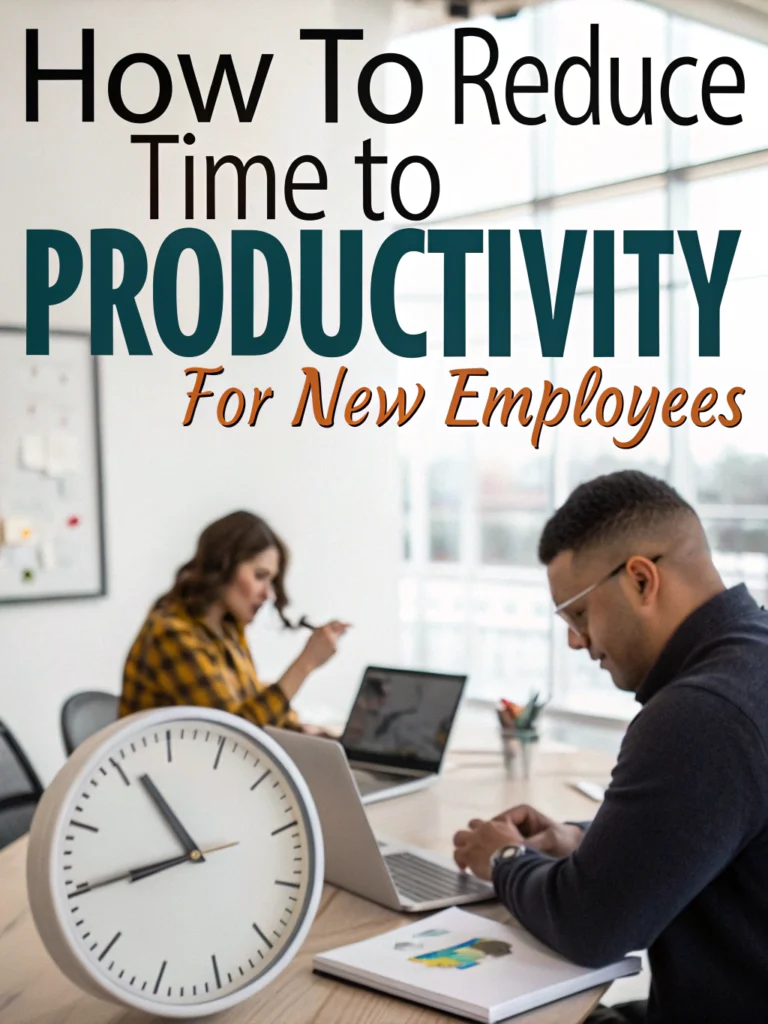How to Reduce Time to Productivity for New Employees
Every day your new hire isn't fully productive costs you real money. Shrinking that time to productivity window isn't just good business—it's critical for staying competitive.
I've seen companies transform their onboarding from a sluggish 6-month journey to a focused 6-week sprint. The difference? Strategic systems that get new talent contributing faster.
Why Time to Productivity Matters Now More Than Ever
When a new employee takes months to reach full productivity, you're essentially paying full salary for partial output. In today's fast-paced business environment, that's a luxury few can afford.
The average company spends up to $4,000 and 24 days to onboard a new employee. Yet many still take 8-12 months to reach full productivity. That gap represents thousands in unrealized value.
Faster employee onboarding isn't just about cost savings—it's about competitive advantage. Organizations that excel at this see:
- 62% higher new hire productivity
- 50% faster time to proficiency
- 54% greater new hire engagement
The Hidden Costs of Slow Onboarding
Before diving into solutions, let's understand what's at stake:
- Direct salary costs during the learning curve
- Manager and mentor time investment
- Opportunity costs of delayed contributions
- Team productivity drag
- Increased risk of early turnover (20% of staff turnover happens in the first 45 days)

7 Proven Strategies to Accelerate Employee Ramp-Up
1. Pre-boarding: Start Before Day One
The onboarding process should begin the moment they accept your offer—not when they first walk through your door.
- Send a welcome package with company swag
- Provide early access to training materials
- Connect them with their team via Slack/Teams
- Set clear expectations about their first week
For teams managing multiple hires, consider leveraging automation tools like those found in the >AI for Productivity eBook + Checklist: Supercharge Your Efficiency in 2125 to streamline these pre-boarding activities.
2. Build a Structured 30-60-90 Day Plan
Vague expectations kill productivity. Detailed roadmaps accelerate it.
Create clear milestone expectations for:
- Technical skills acquisition
- Key relationships to build
- Projects to complete or contribute to
- Decision-making authority at each stage
I've found that breaking down big goals into weekly milestones dramatically speeds up new employee productivity. Make these visible and celebrate progress.
3. Implement the "Buddy System"
Assign each new hire two types of partners:
- Performance Partner: A peer who helps navigate day-to-day job functions
- Culture Partner: Someone who helps integrate them into company culture
This dual approach addresses both the technical and social aspects of onboarding, which can improve new hire performance by up to 87%.
4. Create Learning Sandboxes
Nothing kills productivity like fear of mistakes. Create safe environments where new hires can practice skills without risking real outcomes.
- Simulated client scenarios
- Copy of production systems for practice
- Shadow opportunities with senior staff
- Incremental responsibility allocation
For teams managing employees with focus challenges, strategies from the >ADHD Productivity Power Pack: Ebooks, Guides, Checklists, Workbook & Tools to Master Focus, Time Management & Organization can be particularly effective in designing these learning environments.
5. Create "Just-in-Time" Knowledge Resources
Stop overwhelming new hires with everything at once. Instead, build a knowledge system that delivers information exactly when they need it:
- Video libraries of common procedures
- Process documentation with clear examples
- Decision trees for common scenarios
- FAQ databases built from real questions
Companies using this approach see a 45% reduction in onboarding time while improving knowledge retention by 60%.
6. Implement Rapid Feedback Loops
Don't wait for quarterly reviews to correct course. Build daily or weekly feedback mechanisms:
- 5-minute daily check-ins
- Weekly progress reviews against 30-60-90 plan
- Digital dashboards showing progress
- Peer feedback mechanisms
These quick adjustments prevent small misunderstandings from becoming productivity killers.
7. Adopt Onboarding Best Practices for 2025
The landscape continues to evolve, especially with the rise of remote and hybrid work. Current best practices include:
- Immersive technology onboarding (VR/AR for complex skills)
- Microlearning modules (3-5 minute learning bursts)
- Cross-functional onboarding rotations
- Culture-focused integration activities
- Productivity tools tailored for new employees
Measuring Onboarding Effectiveness
You can't improve what you don't measure. Track these metrics to gauge your program:
- Time to first significant contribution
- Productivity index at 30/60/90 days (compared to tenured employees)
- New hire satisfaction scores
- Knowledge assessment results
- Early turnover rates
Companies tracking these metrics can identify bottlenecks and continuously refine their productivity systems, making improvements based on data rather than assumptions.
Common Pitfalls to Avoid
Even well-intentioned onboarding programs can falter. Watch for these common mistakes:
- Information overload in the first week
- Unclear role expectations
- Insufficient access to tools and resources
- Inadequate introduction to company culture
- Lack of structured feedback
- Isolation from the broader team
Implementing Your Improved Onboarding System
Start by auditing your current onboarding process. Map the employee journey and identify the critical moments where productivity stalls.
Then:
- Prioritize the 2-3 biggest opportunities for improvement
- Design and test new approaches with a small group
- Measure results against your baseline metrics
- Refine and scale successful approaches
- Continue measuring and optimizing
The ROI of Improved Time to Productivity
Companies that excel at reducing time to productivity see concrete financial returns:
- 2.5x higher revenue per employee
- 1.9x higher profit margins
- 70% improvement in customer satisfaction
- 67% better retention rates
Every week you shave off the productivity curve translates to real dollars and competitive advantage.
FAQs About Reducing Time to Productivity
What is the average time to productivity for new employees?
The average time for full productivity ranges from 8-12 months for complex roles, though this varies significantly by industry and role complexity. Top-performing organizations can cut this in half with strategic onboarding.
How can we measure new hire productivity accurately?
Combine objective metrics (sales numbers, tickets closed, projects completed) with manager assessments against role expectations. Create a productivity index comparing new hire output to tenured employees at similar levels.
What's the most common reason for slow productivity ramp-up?
Information fragmentation is the biggest culprit. When knowledge is scattered across people, documents, and systems without clear organization, new hires spend excessive time searching instead of doing.
How do remote work environments affect time to productivity?
Remote environments can extend time to productivity by 20-30% without specialized interventions. The best organizations counter this with structured virtual onboarding, clear documentation, and intentional relationship-building activities.
What's one quick change that can dramatically improve onboarding?
Creating a single, well-organized digital "home base" for all onboarding resources can reduce time to productivity by up to 25%. This eliminates the scavenger hunt for information that plagues most new hires.
Reducing time to productivity isn't just a nice-to-have—it's a strategic imperative. The organizations that master this discipline create sustainable competitive advantage while delivering better experiences for both new hires and the teams they join.

